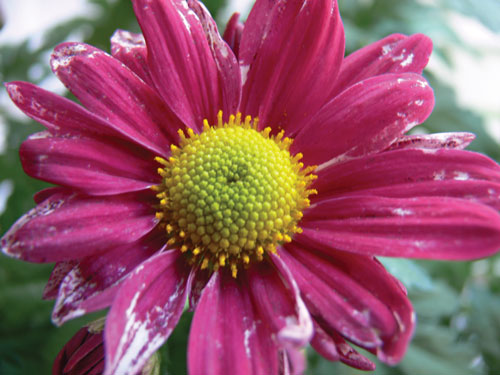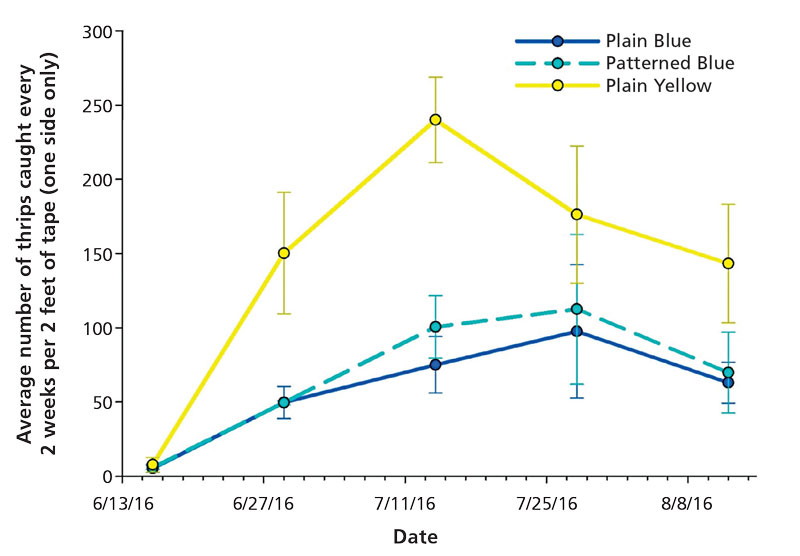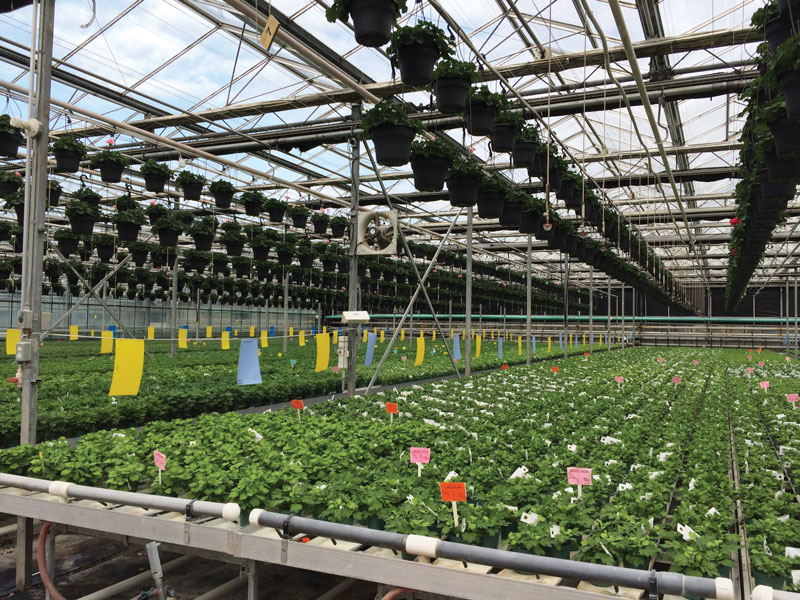6/1/2019
Making Mass Trapping Work for You
Dr. Sarah Jandricic

For greenhouse growers religiously using preventative, mite-based biocontrol programs for thrips control, it can be extremely frustrating (and expensive) to suddenly find yourself in a situation where you need to throw out plants or stems due to visible thrips damage (Figure 1).
Figure 1. Petal streaking caused by thrips feeding, which makes the plant unsellable.
Why do situations like this happen? It’s hard to know for sure, but things like unusually high numbers of thrips eggs in sourced cuttings, hot dry weather or problems with mite sachets (such as improper placement or storage) can all lead to high thrips populations.
What is clear is that more than just predatory mites are needed to keep your thrips biocontrol program consistent and stable. And one of the easiest and cheapest ways to improve your program is with mass trapping.
Mass trapping consists of large sticky cards (16 in. x 8 in.) or long ribbons of sticky tape that attract and trap pests. Sticky traps remove large numbers of adult thrips by intercepting them when they decide to fly—whether that’s when they first enter your greenhouse, when they’re disturbed (e.g., during harvest) or when they just decide to check out some flowering plants on the next bench. As each thrips female can lay over 300 eggs in her lifetime, removing any number of adults lightens the load on your biocontrol program.

How effective is mass trapping?
A study from the U.K. done in strawberries under plastic showed a reduction in the number of thrips from six per flower to less than two per flower when sticky tape was added to the existing IPM program. This corresponded to far lower thrips damage on fruit and increased grower returns.
Figure 2. The average number of thrips caught every two weeks on 2-ft. sections of sticky tape in 2016 trials.
My own research conducted in floriculture greenhouse in Ontario has shown that a staggering number of thrips can be removed using this technique, especially in years with high thrips pressure.
In 2016 (a year that saw high thrips fly-ins in Ontario), we tested different colors and patterns of tape in four commercial chrysanthemum crops (both potted and cut). The best treatment caught more than 150 thrips/2 ft. of tape every week (Figure 2). This means that just in our small trial plots, we caught over 10,000 thrips over a crop cycle. If we’d used this treatment throughout an entire 10,000-sq. ft. greenhouse compartment, we potentially could have caught over 600,000 thrips.

Do it and stick to it
But let’s face it: despite these numbers, some growers still consider mass trapping to be a bit of a nuisance, given its sticky nature. So how do you make it work best for you? A few tips and tricks can help you optimize this tool and view it as a valuable part of your arsenal.
• Get the best bang for your buck: Choosing the right product can be half the battle and there are A LOT of different traps out there. This includes different colors (yellow, white and various shades of blue) and even new patterned tapes that purport to increase thrips catches.
Figure 3. Yellow cards from three different manufacturers (A-C) consistently caught proportionally more thrips than their blue counterparts in a 2017 commercial greenhouse trial in Ontario.
After directly comparing variety trap types, we ultimately found plain yellow traps (regardless of manufacturer; Figure 3) caught more thrips than their blue counterparts. Other pests like whiteflies, fungus gnats, shore flies and leafminers also are much more attracted to yellow, making it a better fit for a comprehensive IPM program.
• You don’t need to place traps directly in the crop: In a direct comparison, we found traps placed down post rows to be just as effective as those in the plant canopy—and much less in the way of tasks like pinching, harvesting and spraying. Place cards so they hang a few inches above the top of the crop (Figure 4).
 Figure 4. A 2017 trial showed no difference in the number of thrips caught if traps were placed in the crop canopy or strung down post rows, for any color/make of trap.
Figure 4. A 2017 trial showed no difference in the number of thrips caught if traps were placed in the crop canopy or strung down post rows, for any color/make of trap.
• Keep your greenhouse from becoming sticky: Many growers don’t like using sticky tape in particular because wrapping it around posts can be messy. However, there are special tape brackets developed for the greenhouse vegetable industry that can be used in floriculture operations to prevent tape from ever touching your poles. Check with your local greenhouse supplier.
• Your type of greenhouse matters: One surprise result that came out of our trials? We only saw differences in yellow vs. blue traps in top-venting greenhouses. In side-venting greenhouses, the ONLY thing that mattered was how close traps were to the vents. Traps placed more than 13 ft. away failed to catch a significant number of thrips. Save money by concentrating traps within 2 to 13 ft. of vent openings.
• Use the right rates: Putting out enough traps is also a key factor in mass trapping. A successful rate in commercial chrsyanthemum operations seems to be 120 large-size cards (four per bench) in a 15,000-sq. ft. zone (i.e., 8 large cards/1,000 sq. ft). But more is always an option!
• Know when to change it: A 2018 duration trial showed little difference between old cards (left up for eight weeks) vs. fresh cards. Changing traps at the end of every eight- to 12-week crop cycle is good practice, though, both to help you monitor pest pressure and to prevent cards from getting too dirty to be effective (from things like potting mix debris and fungus gnats).
The other concern with mass trapping is its effect on biocontrol. Won’t mass trapping, especially yellow traps, reduce the number of flying beneficial insects? As part of our trials, we looked at beneficals inadvertently trapped on yellow vs. blue cards. After releasing high levels of Orius and Atheta coriaria (used for thrips control) and Dicyphus (a leafminer parasitoid), we found only low levels of each on traps of either color a week later (<2/card). Although higher numbers of Aphidius colemani (an aphid parasitoid) were trapped on yellow cards (at around 5/card), many growers in Ontario successfully use Aphidius banker plants and yellow traps together.
Lastly, it’s important to note that all our tests were done in greenhouses with natural and/or HPS lighting. At this point, we don’t know how different LED spectrums might change our results. Different LED mixes—used to improve production or reduce disease—may affect the trap color seen by insects (and therefore their attractiveness).
Until we know more, it’s a good idea to test several colors of traps side-by-side in your own facility. A quick two-week comparison under YOUR conditions, along with the tips and tricks above, can set you on a path to a more reliable thrips control program with mass trapping. GT
Dr. Sarah Jandricic (sarah.jandricic@ontario.ca) is the Greenhouse Floriculture IPM Specialist for the Ontario Ministry of Agriculture, Food and Rural Affairs (OMAFRA) in Canada. She runs the ONFloriculture blog (ONfloriculture.wordpress.com), which provides timely pest management information to floriculture growers.